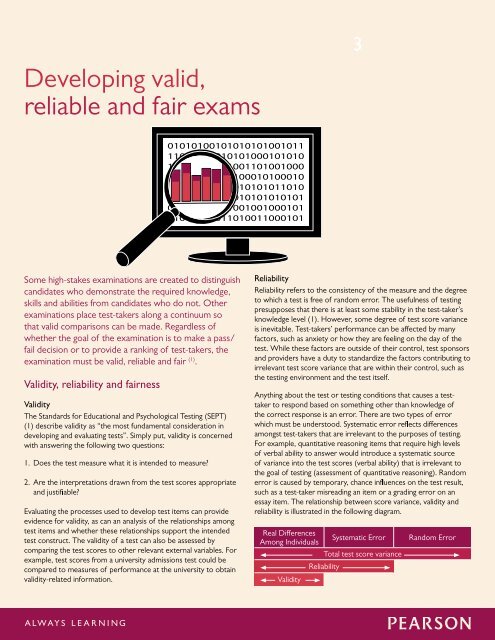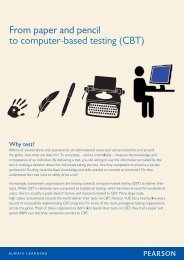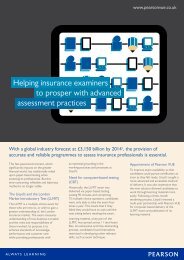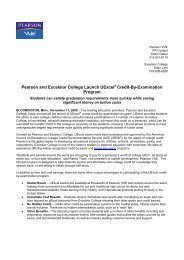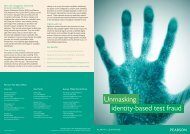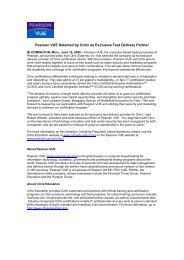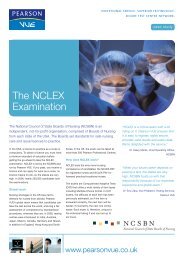Developing valid, reliable and fair exams.pdf - Pearson VUE
Developing valid, reliable and fair exams.pdf - Pearson VUE
Developing valid, reliable and fair exams.pdf - Pearson VUE
Create successful ePaper yourself
Turn your PDF publications into a flip-book with our unique Google optimized e-Paper software.
<strong>Developing</strong> <strong>valid</strong>,<br />
<strong>reliable</strong> <strong>and</strong> <strong>fair</strong> <strong>exams</strong><br />
3<br />
01010100101010101001011<br />
11001010010101000101010<br />
10011100101001101001000<br />
10100100100100010100010<br />
10001010101010101011010<br />
10101011001010101010101<br />
00110010101001001000101<br />
01010101011010011000101<br />
Some high-stakes examinations are created to distinguish<br />
c<strong>and</strong>idates who demonstrate the required knowledge,<br />
skills <strong>and</strong> abilities from c<strong>and</strong>idates who do not. Other<br />
examinations place test-takers along a continuum so<br />
that <strong>valid</strong> comparisons can be made. Regardless of<br />
whether the goal of the examination is to make a pass/<br />
fail decision or to provide a ranking of test-takers, the<br />
examination must be <strong>valid</strong>, <strong>reliable</strong> <strong>and</strong> <strong>fair</strong> (1) .<br />
Validity, reliability <strong>and</strong> <strong>fair</strong>ness<br />
Validity<br />
The St<strong>and</strong>ards for Educational <strong>and</strong> Psychological Testing (SEPT)<br />
(1) describe <strong>valid</strong>ity as “the most fundamental consideration in<br />
developing <strong>and</strong> evaluating tests”. Simply put, <strong>valid</strong>ity is concerned<br />
with answering the following two questions:<br />
1. Does the test measure what it is intended to measure<br />
2. Are the interpretations drawn from the test scores appropriate<br />
<strong>and</strong> justifiable<br />
Evaluating the processes used to develop test items can provide<br />
evidence for <strong>valid</strong>ity, as can an analysis of the relationships among<br />
test items <strong>and</strong> whether these relationships support the intended<br />
test construct. The <strong>valid</strong>ity of a test can also be assessed by<br />
comparing the test scores to other relevant external variables. For<br />
example, test scores from a university admissions test could be<br />
compared to measures of performance at the university to obtain<br />
<strong>valid</strong>ity-related information.<br />
Reliability<br />
Reliability refers to the consistency of the measure <strong>and</strong> the degree<br />
to which a test is free of r<strong>and</strong>om error. The usefulness of testing<br />
presupposes that there is at least some stability in the test-taker’s<br />
knowledge level (1). However, some degree of test score variance<br />
is inevitable. Test-takers’ performance can be affected by many<br />
factors, such as anxiety or how they are feeling on the day of the<br />
test. While these factors are outside of their control, test sponsors<br />
<strong>and</strong> providers have a duty to st<strong>and</strong>ardize the factors contributing to<br />
irrelevant test score variance that are within their control, such as<br />
the testing environment <strong>and</strong> the test itself.<br />
Anything about the test or testing conditions that causes a testtaker<br />
to respond based on something other than knowledge of<br />
the correct response is an error. There are two types of error<br />
which must be understood. Systematic error reflects differences<br />
amongst test-takers that are irrelevant to the purposes of testing.<br />
For example, quantitative reasoning items that require high levels<br />
of verbal ability to answer would introduce a systematic source<br />
of variance into the test scores (verbal ability) that is irrelevant to<br />
the goal of testing (assessment of quantitative reasoning). R<strong>and</strong>om<br />
error is caused by temporary, chance influences on the test result,<br />
such as a test-taker misreading an item or a grading error on an<br />
essay item. The relationship between score variance, <strong>valid</strong>ity <strong>and</strong><br />
reliability is illustrated in the following diagram.<br />
Real Differences<br />
Among Individuals<br />
Validity<br />
Systematic Error<br />
Total test score variance<br />
Reliability<br />
R<strong>and</strong>om Error
<strong>Developing</strong> <strong>valid</strong>, <strong>reliable</strong> <strong>and</strong> <strong>fair</strong> <strong>exams</strong><br />
Fairness<br />
As the (SEPT) (1) point out, “the term <strong>fair</strong>ness is used in many<br />
different ways <strong>and</strong> has no single technical meaning.” The St<strong>and</strong>ards<br />
outline four ways in which the term can be used in relation to<br />
testing: A) the absence of bias, B) <strong>fair</strong> treatment with regard to<br />
test procedures, test scoring, <strong>and</strong> the use of scores, C) equality of<br />
outcomes in testing so that test-takers of equivalent ability should<br />
have equivalent test results regardless of group membership (for<br />
example, race or ethnicity), <strong>and</strong> D) equitable opportunities to learn<br />
the material covered by the test.<br />
The incorporation of item bias <strong>and</strong> sensitivity reviews during<br />
the item development process can be supplemented by the use<br />
of statistical measures to identify items which have a different<br />
probability of a correct response for different test-taker subgroups.<br />
A psychometric analysis of differential item functioning (DIF)<br />
identifies items that perform differently across subgroups of testtakers<br />
(e.g. gender, ethnicity, sociodemographic status, age) while<br />
controlling for the ability of the test-takers. That is, the probability<br />
of a correct response differs dependent on group membership<br />
even for test-takers with the same ability. Items flagged for DIF<br />
are subject to greater content scrutiny to investigate potential bias<br />
<strong>and</strong> justify their continued inclusion in the item bank. It should be<br />
stressed that differential item functioning does not automatically<br />
equate to bias – there may be legitimate reasons as to why an item<br />
performs differently for different subgroups.<br />
St<strong>and</strong>ard setting, test assembly <strong>and</strong> equating are important to<br />
establishing <strong>fair</strong>ness in test procedures <strong>and</strong> test scoring. These<br />
concepts are discussed in the subsequent sections.<br />
St<strong>and</strong>ard setting<br />
For examinations that require a pass/fail decision, a passing<br />
st<strong>and</strong>ard must be established. There are three general methods for<br />
setting a pass mark:<br />
1. Holistic – An arbitrary fixed percentage pass mark (for example,<br />
60%)<br />
2. Norm-referenced – A fixed pass rate (for example, the top 60%<br />
of test-takers)<br />
3. Criterion-referenced – Setting the pass mark at an absolute<br />
st<strong>and</strong>ard that denotes the required level of competence<br />
A holistic pass mark is the least appropriate. Unless there is a<br />
rationale for using a norm-referenced st<strong>and</strong>ard (for example, a<br />
limited number of placements available for a training program),<br />
criterion-referenced st<strong>and</strong>ards are preferred. For high-stakes<br />
examinations, such as licensure or certification tests, criterionreferenced<br />
st<strong>and</strong>ard setting is widely recognized as the method of<br />
choice. <strong>Pearson</strong> <strong>VUE</strong> psychometricians employ criterion-referenced<br />
st<strong>and</strong>ard-setting procedures that have been developed based upon<br />
universally-accepted psychometric practices.<br />
Test assembly<br />
<strong>Pearson</strong> <strong>VUE</strong> has extensive experience with test assembly for<br />
computer-based examinations. Our content developers <strong>and</strong><br />
psychometricians work with clients to choose an appropriate<br />
test administration model, including fixed-form, linear-on-the-fly<br />
(LOFT) or adaptive test design. In the fixed-form design, a specified<br />
number of content- <strong>and</strong> statistically-equivalent exam versions<br />
(forms) are assembled. In a LOFT test design, items are r<strong>and</strong>omly<br />
selected from the item pool for examination inclusion to fulfil a<br />
prescribed series of content <strong>and</strong> statistical rules. In adaptive testing,<br />
items are selected to test an individual test-taker based upon an<br />
underst<strong>and</strong>ing of the test-taker’s ability level as identified through<br />
Glossary of Terms<br />
Classical test theory (CTT)<br />
An exam development <strong>and</strong> evaluation<br />
framework derived from the premise that<br />
any test score can be expressed as the sum<br />
of two independent components – 1) the<br />
test-taker’s true st<strong>and</strong>ing on the construct<br />
of interest, <strong>and</strong> 2) r<strong>and</strong>om error. Test<br />
items are characterized in terms of the<br />
proportion of a specified population able<br />
to correctly answer the item (item difficulty<br />
or p value)<br />
<strong>and</strong> the point-biserial correlation between<br />
item score <strong>and</strong> test score (item-test<br />
correlation). Test-takers are scored using<br />
some function of the number of items<br />
answered correctly.<br />
Computerized adaptive testing (CAT)<br />
A computer-based test in which successive<br />
items are selected from a pool of items<br />
based on the test-taker’s performance on<br />
previous items. Based in<br />
item response theory (IRT), this type of<br />
testing is intended to select items that are<br />
of appropriate difficulty for the test-taker.<br />
Good performance by the test-taker<br />
leads to more difficult questions; poor<br />
performance leads to easier questions.<br />
Adaptive tests can be fixed or variable in<br />
length.
his or her responses to previous questions. Thus, the examination<br />
“adapts” to an individual test-taker’s ability level <strong>and</strong> more precisely<br />
measures that test-taker’s proficiency. Considerations for optimal<br />
test design include the size <strong>and</strong> quality of the item bank, the<br />
number of test-takers <strong>and</strong> the frequency of test administration.<br />
Equating <strong>and</strong> scaling<br />
Through the procedure known as equating, passing st<strong>and</strong>ard values<br />
are adjusted so that an equivalent level of proficiency is required<br />
to pass different versions of the examination. The goal of this<br />
process is to make sure that each test-taker receives a statistically<br />
equivalent examination: one that is neither statistically easier nor<br />
harder than that received by any other test-taker.<br />
A method typically utilized by <strong>Pearson</strong> <strong>VUE</strong> employs IRT to<br />
calibrate items from two or more test forms to the same scale.<br />
IRT uses statistical models to quantitatively link all item parameters<br />
to a common benchmark scale. <strong>Pearson</strong> <strong>VUE</strong> then develops an<br />
IRT-calibrated item bank. When items are linked to a common<br />
scale, test forms can be created <strong>and</strong> passing st<strong>and</strong>ards set such that<br />
slight differences in test difficulty across forms are accounted for.<br />
Test forms are drawn from the calibrated item bank <strong>and</strong> no item<br />
appears on a test before it has been trialled <strong>and</strong> equated to the<br />
benchmark scale. If a fixed-form test design is used, a fixed number<br />
of equated forms are prepared <strong>and</strong> are available for administration.<br />
A test form is r<strong>and</strong>omly selected for each test-taker. If a LOFT test<br />
design is used, the test form is assembled as the test-taker begins<br />
the computer-based test.<br />
Test functionality<br />
In addition to making decisions on the psychometric properties of<br />
the tests, test sponsors delivering tests in a CBT environment also<br />
need to consider which computerized features are appropriate<br />
for the desired measurement. The variety of functionality allowed<br />
through CBT means that technical test specifications are necessary<br />
as a complement to the test plan or test blueprint (the outline of<br />
the content requirements). Technical specifications may include the<br />
following details on items <strong>and</strong> their display in a CBT environment:<br />
• Navigation between test items<br />
• Guidelines on the inclusion of graphical images (for example,<br />
size <strong>and</strong> format)<br />
• Ancillary information to display with the test items (such as<br />
exhibits, instructions, calculators) <strong>and</strong> the format in which<br />
these will be displayed<br />
• Whether or not test-takers are allowed to go back to<br />
previous screens of the test or previous items<br />
When implementing CBT as a testing method, care should be<br />
exercised to ensure that its functionality enhances, <strong>and</strong> does not<br />
interfere, with the assessment of test-takers’ ability related to the<br />
testing purpose (2) .<br />
By working with <strong>Pearson</strong> <strong>VUE</strong> <strong>and</strong> through careful development of<br />
tests according to psychometric best practices <strong>and</strong> the considerate<br />
use of CBT functionality, test sponsors can create examinations<br />
that are <strong>valid</strong>, <strong>reliable</strong>, <strong>and</strong> <strong>fair</strong>.<br />
References<br />
1: American Educational Research Association, American Psychological<br />
Association, & National Council on Measurement in Education. (1999).<br />
St<strong>and</strong>ards for educational <strong>and</strong> psychological testing. Washington, DC:American<br />
Educational Research Association.<br />
2: International Test Commission (2005). International Guidelines on Computer-<br />
Based <strong>and</strong> Internet Delivered Testing. http://www.intestcom.org/Downloads/<br />
ITC%20Guidelines%20on%20Computer%20-20version%202005%20approved.<br />
<strong>pdf</strong> (Retrieved 8 January 2012).<br />
de Klerk, G. Classical test theory (CTT). In M. Born, C.D. Foxcroft & R.<br />
Butter (Eds.), Online Readings in Testing <strong>and</strong> Assessment, International Test<br />
Commission, http://www.intestcom.org/Publications/ORTA.php (Retrieved 5<br />
December 2011).<br />
Construct irrelevant variance<br />
“The degree to which the test scores are<br />
affected by processes that are extraneous<br />
to its intended construct” (AERA, APA,<br />
NCME, 1999, p. 10)<br />
Construct underrepresentation<br />
“The degree to which a test fails to capture<br />
important aspects of the construct”<br />
(AERA, APA, NCME, 1999, p. 10)<br />
Equating<br />
The process of statistically adjusting the<br />
scoring of alternate forms of a test so that<br />
they use the same scoring scale.<br />
Item response theory (IRT)<br />
A statistical model for analyzing test-takers’<br />
performance on a set of test questions<br />
(items). Its basic assumption is that the<br />
probability that a test-taker will answer a<br />
test question correctly<br />
depends on one characteristic of the<br />
test-taker (called “ability”) <strong>and</strong> on one to<br />
three characteristics of the test question.<br />
The three characteristics of the test<br />
question are indicated by numbers called<br />
“parameters.”
<strong>Pearson</strong> <strong>VUE</strong> Sales Offices<br />
Americas<br />
Global Headquarters<br />
Minneapolis, MN<br />
+01 800 837 8969<br />
pvamericassales@pearson.com<br />
www.pearsonvue.com<br />
Philadelphia, PA<br />
+01 610 617 9300<br />
pvamericassales@pearson.com<br />
www.pearsonvue.com<br />
Chicago, IL<br />
+01 800 837 8969<br />
pvamericassales@pearson.com<br />
www.pearsonvue.com<br />
Asia Pacific<br />
Delhi, India<br />
+91 120 4001600<br />
pvindiasales@pearson.com<br />
www.pearsonvue.com<br />
Beijing, China<br />
+86 10 6849 2066<br />
pvchinasales@pearson.com<br />
www.pearsonvue.com.cn<br />
Tokyo, Japan<br />
+81 3 5214 0888<br />
pvjsales@pearson.com<br />
www.pearsonvue.com/japan<br />
Europe, Middle East & Africa<br />
Manchester, United Kingdom<br />
+44 0 161 855 7000<br />
vuemarketing@pearson.com<br />
www.pearsonvue.co.uk<br />
London, United Kingdom<br />
+44 0 161 855 7000<br />
vuemarketing@pearson.com<br />
www.pearsonvue.co.uk<br />
Dubai, United Arab Emirates<br />
+971 44 535300<br />
vuemarketing@pearson.com<br />
www.pearsonvue.ae<br />
Committed to developing<br />
<strong>valid</strong>, <strong>reliable</strong> <strong>and</strong> <strong>fair</strong> <strong>exams</strong><br />
To learn more, visit www.pearsonvue.com<br />
PV/3 Test Dev/US/9-12<br />
Copyright © 2012 <strong>Pearson</strong> Education, Inc. or its affiliate(s). All rights reserved. 800 837 8969


